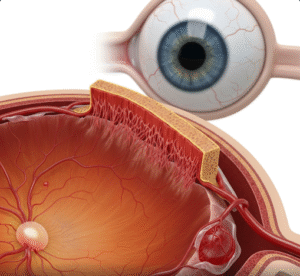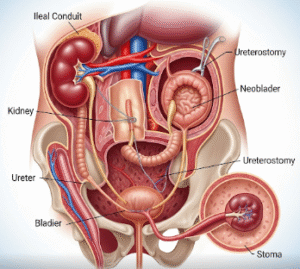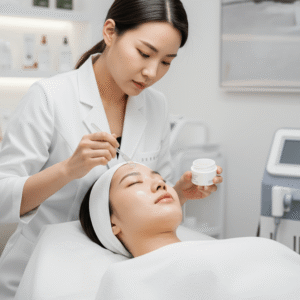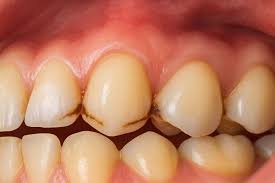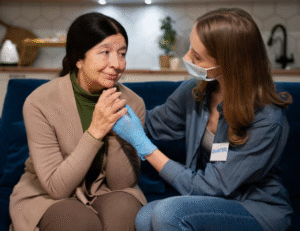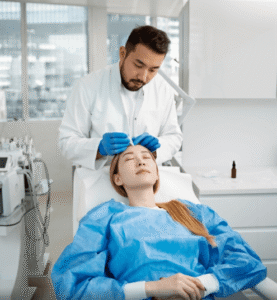Overview
Eye twitching, medically known as myokymia, refers to involuntary, repetitive spasms of the eyelid muscles. These twitches are usually harmless but can cause discomfort, fatigue, and distraction. Eye twitching commonly affects the lower eyelid, though the upper eyelid may also be involved. In Korea, ophthalmology clinics and neurology centers offer comprehensive evaluation, management, and treatment for persistent or severe eye twitching, ensuring proper care and monitoring for underlying conditions.
Highlights:
➤ Involuntary eyelid spasms – Usually mild and temporary
➤ Commonly triggered by fatigue, stress, or eye strain
➤ Can indicate underlying neurological or ocular conditions if persistent
Key Facts
➤ Prevalence: Eye twitching is common across all age groups, particularly adults
➤ Age affected: More frequent in adults aged 30–50, but can occur in children
➤ Gender: Both males and females are equally affected
➤ Impact: May cause annoyance, visual disturbance, or interference with daily tasks
➤ Prognosis: Most cases are benign and self-limiting; persistent twitching requires medical evaluation
What is Eye Twitching?
Eye twitching is repetitive, involuntary contraction of eyelid muscles, usually the orbicularis oculi. It is typically benign and short-lived, but can become chronic in some cases. Types of eye twitching include:
- Benign eyelid myokymia: Most common, usually temporary
- Hemifacial spasm: Involves one side of the face, often due to nerve compression
- Blepharospasm: Forceful, repetitive eyelid closure affecting both eyes, sometimes related to neurological conditions
Key characteristics:
- Rapid, intermittent twitching
- Usually painless but may cause discomfort or fatigue
- Can worsen with stress, caffeine intake, or lack of sleep
Highlights:
➤ Often benign and self-limiting
➤ Chronic or severe twitching may indicate neurological issues
➤ Common triggers include fatigue, eye strain, and stress
What Symptoms Are Related to Eye Twitching?
➤ Repetitive eyelid movement – Usually the upper or lower eyelid
➤ Mild irritation or discomfort – Occasional burning or dryness
➤ Increased sensitivity to light (photophobia) – Rare, usually secondary to eye strain
➤ Eye fatigue – Especially after prolonged screen time or reading
➤ Facial muscle twitching – In hemifacial spasm
➤ Difficulty keeping the eye open – In severe blepharospasm
Highlights:
➣ Symptoms are usually temporary and harmless
➣ Persistent or worsening twitching may require medical evaluation
What Causes / Possible Causes
➤ Fatigue or lack of sleep: Most common trigger
➤ Stress or anxiety: Increases muscle excitability
➤ Eye strain: Prolonged screen time, reading, or uncorrected vision problems
➤ Caffeine or alcohol intake: Can exacerbate muscle twitching
➤ Dry eyes or irritation: Can trigger eyelid spasms
➤ Neurological disorders: Hemifacial spasm, blepharospasm, or cranial nerve disorders
➤ Medication side effects: Certain drugs affecting the nervous system may contribute
Highlights:
➣ Causes range from benign lifestyle factors to underlying neurological conditions
➣ Identifying triggers can help prevent recurrence
When Should I See My Doctor?
➤ Persistent twitching lasting more than a few weeks
➤ Involvement of other facial muscles – Could indicate hemifacial spasm
➤ Drooping eyelid or abnormal eye closure – May suggest blepharospasm or nerve involvement
➤ Pain, swelling, or redness – Could indicate infection or inflammation
➤ Vision changes or double vision – Requires urgent evaluation
Highlights:
➣ Early consultation with a Korean ophthalmologist or neurologist ensures proper diagnosis
➣ Timely evaluation prevents misdiagnosis and addresses underlying causes
Care and Treatment
➤ Lifestyle modifications: Adequate sleep, stress management, and reduced caffeine intake
➤ Warm compresses: Relax eyelid muscles and reduce irritation
➤ Lubricating eye drops: For dry eyes contributing to twitching
➤ Proper eye care: Regular breaks from screens and proper lighting
➤ Botulinum toxin injections: For chronic or severe blepharospasm or hemifacial spasm
➤ Surgery: Rarely required, reserved for persistent hemifacial spasm unresponsive to other treatments
➤ Monitoring: Tracking frequency, duration, and triggers of twitching
Highlights:
➣ Most cases are self-limiting and respond to lifestyle adjustments
➣ Medical or surgical interventions are reserved for persistent or severe cases
Treatment Options in Korea
Medical Treatments:
➤ Ophthalmology clinics: Evaluation of eye health, dryness, and vision issues
➤ Neurology centers: Assessment for hemifacial spasm, blepharospasm, or nerve compression
➤ Botulinum toxin therapy: Non-invasive treatment for chronic eyelid spasms
Advanced Procedures:
➤ Surgical decompression: For hemifacial spasm caused by nerve compression
➤ Electromyography and imaging: For chronic or complex cases
➤ Follow-up care: Regular monitoring to track improvement and manage recurrence
Rehabilitation & Follow-Up Care:
➤ Education on stress management, screen hygiene, and eye care
➤ Ongoing evaluation for patients with chronic neurological or ocular conditions
➤ Multidisciplinary care for complex cases involving ophthalmology and neurology
Highlights:
➣ Korean clinics provide comprehensive evaluation, non-invasive therapy, and advanced interventions
➣ Early management ensures relief, prevents complications, and improves quality of life


